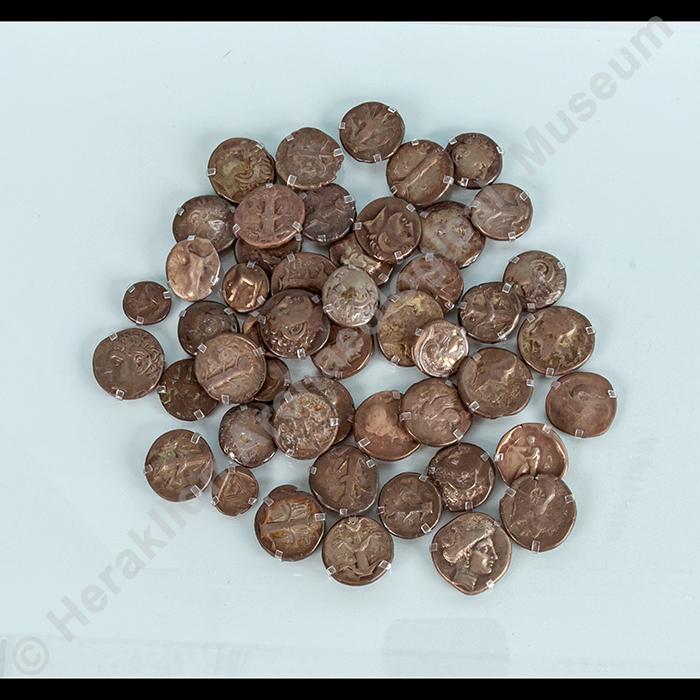Coin hoard from Mitropolis (Gortyn)
Ν1090 - Ν1138
Metal (Silver)
Fair to good
Diameter: stater: 2.4 cm. Drachms: 1.7-2.1 cm. Pegasoi: 1.9-2.2 cm. Didrachms: 7.5-7.9 cm. Triobols: 1.4-1.6 cm. Respective weight: 10.82 / 5.11-5.48 / 8.13-8.34 / 7.5-7.9 / 2.46-2.7 gr.
Mitropolis (ancient Gortyn)
Classical - Hellenistic period:
Minted: late 4th-early 3rd c. BC Concealed: 280-270 BC:
Gallery:
XXICase:
208Exhibition thematic unit:
Cretan CoinageCoin Hoards
Description
A coin hoard recorded in an archival source as consisting of over 100 silver coins, 49 of which were confiscated and are now in the Heraklion Archaeological Museum. Several Cretan mints are represented, including those of Kydonia (1 stater, 3 drachms), Gortyn (1 drachm), Lyttos (1 drachm) and Itanos (1 drachm). There are also the non-Cretan staters of Corinth and its colonies (Thyrium, Anactorion, Amphilochian Argos, Syracuse), known as “foals” because they bear an image of Pegasus; these are common on the island in the late 4th and 3rd centuries BC. Other coins are didrachms of Cyrene (on the North African coast) depicting silphium, a healing herb, and triobols of Argos, the smallest denominations in the hoard. The collection and concealment of the hoard in c. 280-270 BC render it one of the typical and relatively numerous caches of coins during a rather turbulent period in the territory of Gortyn and Crete generally.Bibliography:
Inventory of Greek Coin Hoards 151. G. Le Rider, Monnaies Crétoises du Ve au Ier siécle av. J.C., Paris 1966, 7-11. K. Sidiropoulos, "Hoards from Crete or the island on foreign footsteps", in R. Cantilena – F. Carbone, Monetary and Social Aspects of Hellenistic Crete, Proceedings of the International Conference (Athens, 13-14 June 2018), Annuario della Scuola Archeologica di Atene Suppl. 4, 2019, p. Χ.Author:
K. S.Photographs' metadata
